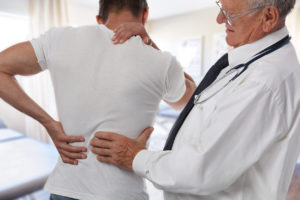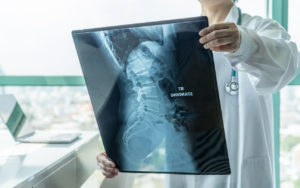TWO OFFICES IN NEW YORK CITY • Hablamos Español

Back Injury
Click For Your Free ConsulationNYC Personal Injury Lawyer » New York Personal Injury Resources » Types of Injuries » Back Injury
 Back injuries happen frequently. Back pain causes more days of missed work than any other injury. American businesses lose over 83 million workdays every year due to employees with back pain.
Back injuries happen frequently. Back pain causes more days of missed work than any other injury. American businesses lose over 83 million workdays every year due to employees with back pain.
In the past year, 25% of American adults have experienced back pain. And 8% of American adults say they experience chronic back pain. These injuries result from trauma, disease, and overuse.
Here are some details to know about back injuries and how you can claim compensation if you suffer from one.
Table of Contents
 Your back must perform several conflicting functions. It must provide the strength to support your weight when you stand, sit, and walk. At the same time, it must have the flexibility to allow you to twist and bend your body.
Your back must perform several conflicting functions. It must provide the strength to support your weight when you stand, sit, and walk. At the same time, it must have the flexibility to allow you to twist and bend your body.
Your back must have the rigidity to protect your spinal cord. But it must also cushion your body when you run and jump.
To accomplish all these functions, your back contains several structures that work together. Your spine provides the structure for your back. It helps you carry your body weight. It also provides a place for muscles and ligaments to anchor.
Your spine includes vertebrae to provide strength and structure to your back. Each vertebra has a cylindrical body and wing-shaped processes. The spinal cord runs through the gap between the body and processes.
Ligaments hold the vertebrae together to form a continuous structure. But between each pair of vertebrae sits a cylindrical disc. The disc has a fibrous annulus surrounding a gel-like nucleus. The disc is tough, yet bouncy. It cushions and lubricates the adjacent vertebrae so they can move smoothly.
Your back muscles move your body. These muscles allow you to bend and twist. They also help you maintain your posture.
The muscles attach to your vertebrae through tendons. The tendons and ligaments attach to the spinous processes.
Almost all back injuries happen as a result of:
A traumatic accident can injure your back. This can happen as a result of landing on your back or if something punctures your back. It can also happen when your body experiences extreme forces and your body weight injures your back.
In a slip and fall accident, your back could impact the ground. This impact could damage the bones and soft tissues of your back.
In a car accident, by contrast, your back usually does not experience a direct impact. Instead, the rapid deceleration in the collision causes your body to bend and twist. This rapid motion causes your spine to hyperextend, then compress. These forces can injure your back.
Other accidents that can cause back injuries include:
Any number of accidents can cause serious injury to your back. Or, you could suffer a back injury as a result of medical malpractice.
Diseases like cancer or osteoporosis can weaken the structures in your back. This can cause misalignment and lead to fractures, pain, and nerve injuries.
Over time, the structures in your back wear out. The discs become dry. And the burden of carrying your weight can deform your discs.
Repetitive stresses on your back can cause stress fractures. These tiny cracks can worsen if you do not take time to heal. Stress injuries can result from jobs where you repeatedly walk, lift, carry, or stand.
Back injuries can happen in many different ways. The type of back injury you suffer will determine the treatment and prognosis for your back.
Some examples of back injuries include:
Strains happen when you stretch or tear a muscle or tendon. Stress on your back from trauma or overuse can damage the muscles and tendons.
Some symptoms of a strained back include:
Sprains happen when you stretch or tear a ligament. Trauma can damage the tendons that hold the vertebrae together.
Symptoms of a back sprain include:
Treatment for back strains and sprains usually includes rest, ice, and anti-inflammatory drugs. As you recover from your injury, your doctor might also prescribe exercise and physical therapy. Physical therapy can help heal the injury and strengthen the surrounding muscles, tendons, and ligaments to support the injured tissue.
Trauma or overuse can fracture a vertebra. When a vertebra fractures, the nerves in and around the fracture inflame and you will experience severe pain. Your back will feel unstable and you may even see some deformation of your back.
A broken back is a serious injury. Doctors will often order rest and immobilization with a brace to reduce the risk of a spinal cord injury. The bone will heal in about six weeks.
When a disc gets compressed, the outer annulus can weaken and deform under your weight. The disc can bulge, forming a barrel shape rather than a cylinder. This bulge can press on the spinal cord, causing a range of nerve symptoms.
Compression can also cause the outer annulus to separate. The inner nucleus herniates through the gaps in the annulus. A herniated disc can also press on the spinal cord.
A spinal cord injury can result from back trauma. Nerves cannot function when they get severed or compressed. A sprained or strained back can allow a vertebra to slip out of place and press on the spinal cord. A bone fragment from a fractured vertebra can migrate into the spinal canal, damaging the nerves. A compressed disc can push on the spinal cord.
If your back injury occurred on the job, in most cases, you’re entitled to workers’ compensation benefits. When you suffer a back injury due to someone else’s negligence, you can typically seek compensation from them in a personal injury lawsuit. Your compensation can cover both your economic and non-economic losses.
Economic damages generally cover your out-of-pocket costs, like medical bills and lost wages. But you can also usually seek compensation for non-financial losses like physical pain, mental suffering, and the other ways your injury diminished your quality of life.
A back injury can cause chronic pain and permanent disability. As a result, your back injury might prevent you from working or even performing necessary daily tasks like dressing or bathing.
To discuss the compensation you can seek for the impact of a back injury, contact a reputable personal injury lawyer for help.
Search Our Site
Our Locations
New York City Office
450 7th Ave Suite 1605
New York, NY 10123
(212) 564 2800
Brooklyn Office
26 Court St., Suite 2511
Brooklyn, NY 11242
(718) 802-1600
We are available to take your call 24/7
